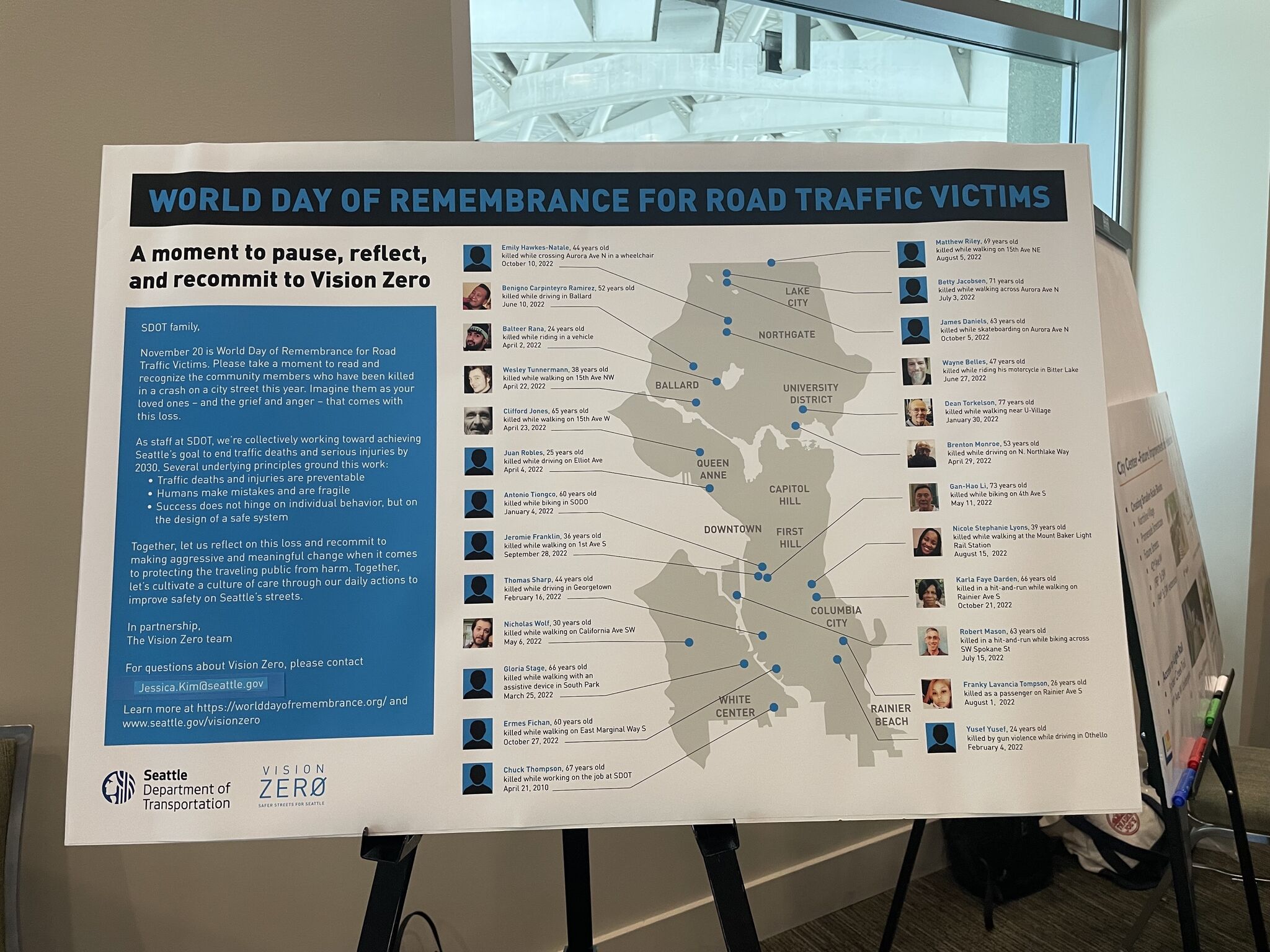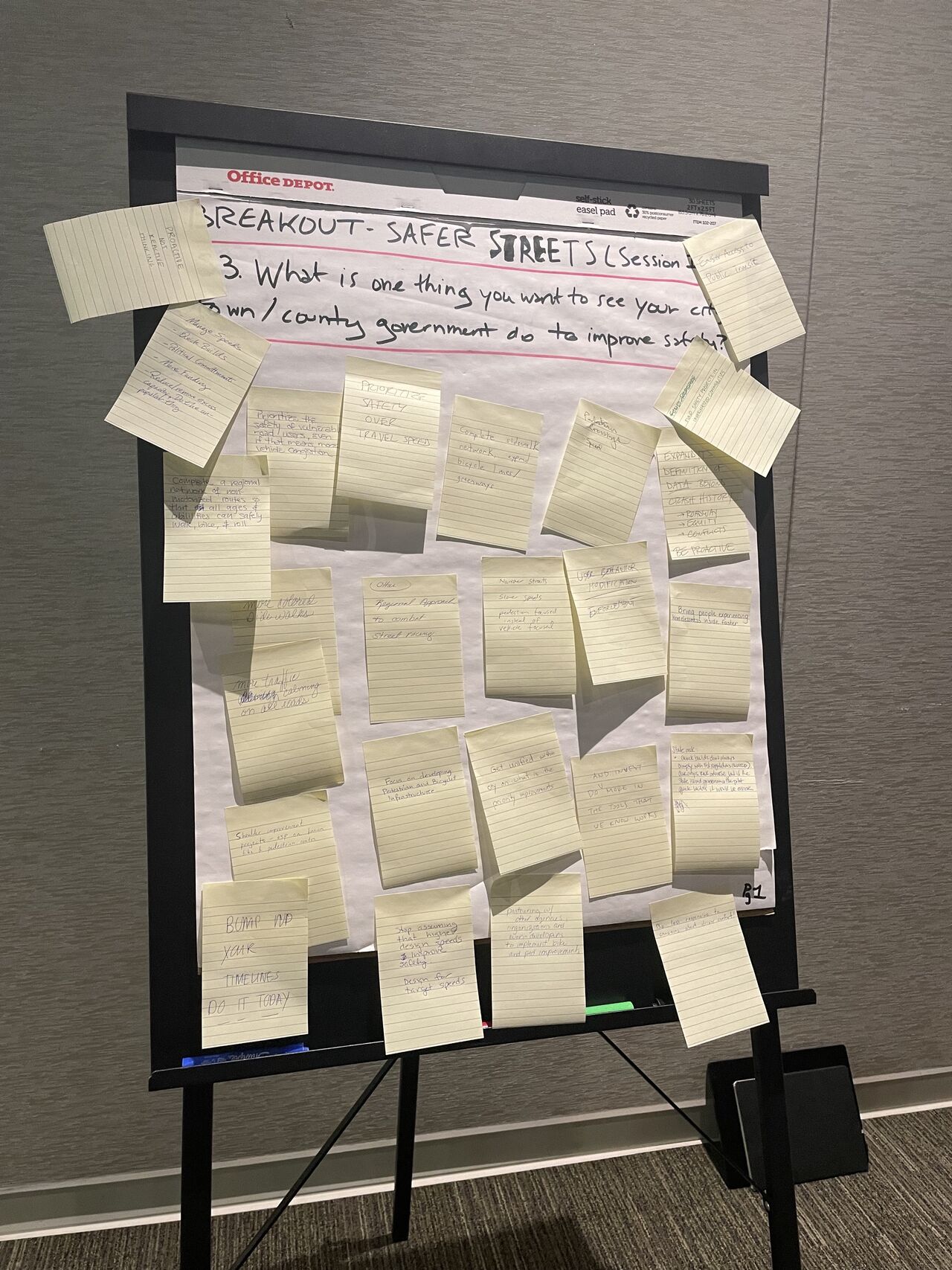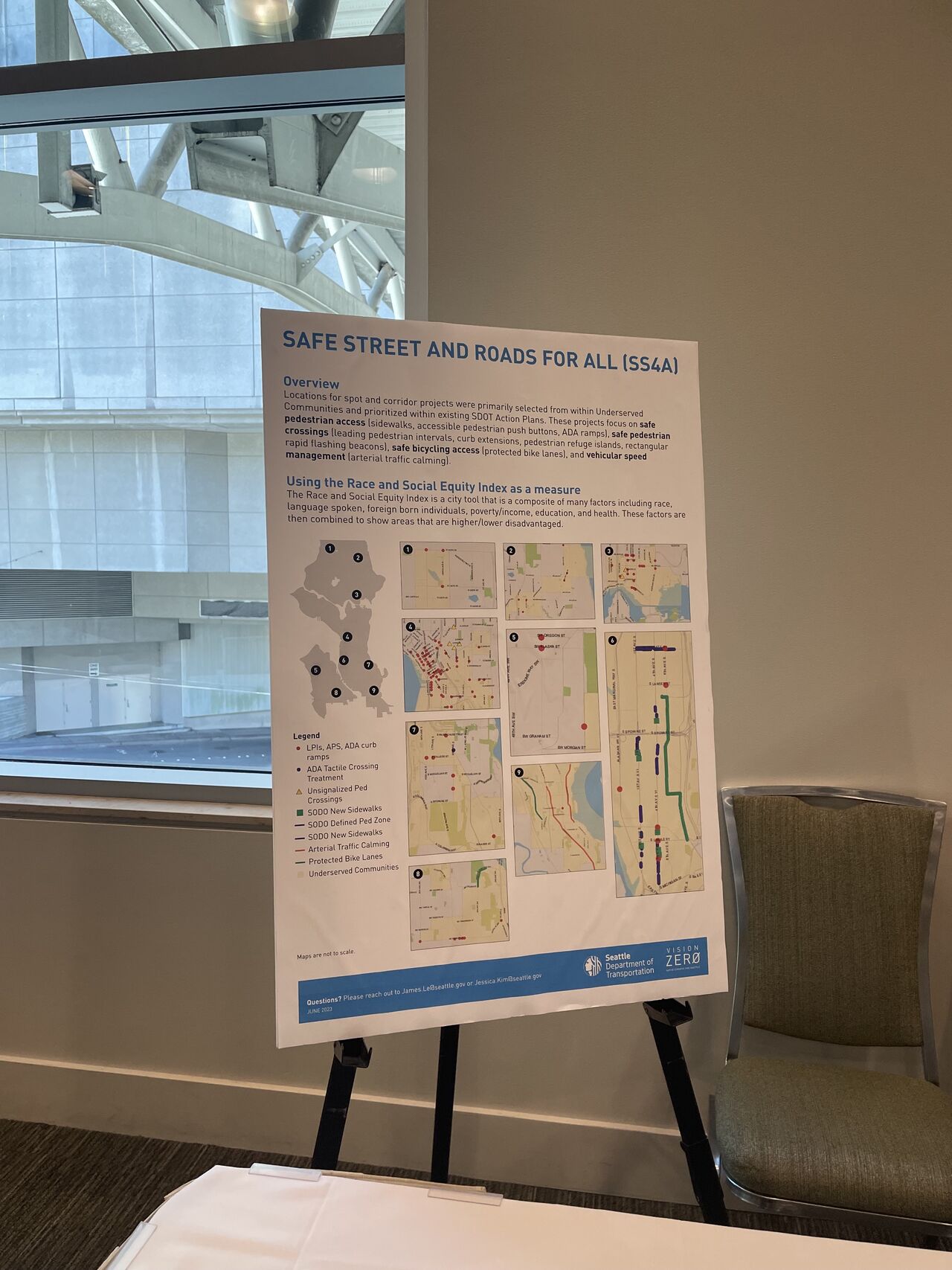- About Us
- Events & Training
- Professional Development
- Sponsorship
- Get Involved
- Resources
Safety Takes Center Stage: Insights from the PSRC Regional Safety SummitBy Riya Debnath, Senior Consultant, Transportation Planner, WSP Global Inc., Seattle On June 29th, the Seattle Convention Center was abuzz with energy and anticipation. Delegates from across the region had gathered for the inaugural Puget Sound Regional Council (PSRC) Regional Safety Summit. Hopefully, this groundbreaking summit was the first of many. It provided a platform for diverse voices to converge, all committed to one urgent, shared goal: improving transportation safety to achieve zero fatalities and serious injuries. The event united elected officials, transportation experts, engaged citizens, and stakeholders, marking a pivotal point in the history of regional safety. On June 29th, the Seattle Convention Center was abuzz with energy and anticipation. Delegates from across the region had gathered for the inaugural Puget Sound Regional Council (PSRC) Regional Safety Summit. Hopefully, this groundbreaking summit was the first of many. It provided a platform for diverse voices to converge, all committed to one urgent, shared goal: improving transportation safety to achieve zero fatalities and serious injuries. The event united elected officials, transportation experts, engaged citizens, and stakeholders, marking a pivotal point in the history of regional safety. Before delving into the summit proceedings, it is essential to understand the historical context that underscores its significance. The National Roadway Safety Strategy (NRSS), rooted in global best practices, has laid the foundation for an all-inclusive approach to road safety. Its guiding principle, the Safe Systems Approach, emphasizes the shared responsibility of everyone involved in the system, including road users, policymakers, planners, and vehicle manufacturers. The NRSS vision prioritizes safety and seeks to transform transportation networks to be more forgiving of human error. This historical context magnifies the importance of summits such as the PSRC's, which play a crucial role in bringing the NRSS vision to life. Before delving into the summit proceedings, it is essential to understand the historical context that underscores its significance. The National Roadway Safety Strategy (NRSS), rooted in global best practices, has laid the foundation for an all-inclusive approach to road safety. Its guiding principle, the Safe Systems Approach, emphasizes the shared responsibility of everyone involved in the system, including road users, policymakers, planners, and vehicle manufacturers. The NRSS vision prioritizes safety and seeks to transform transportation networks to be more forgiving of human error. This historical context magnifies the importance of summits such as the PSRC's, which play a crucial role in bringing the NRSS vision to life. PSRC Executive Director Josh Brown marked the summit's commencement, and King County Councilmember Claudia Balducci welcomed the participants. Following this, Scott Goldstein, Deputy Assistant Secretary for Transportation Policy at the U.S. Department of Transportation, provided an overview of the Safe Systems Approach, elucidating federal priorities and initiatives. PSRC Executive Director Josh Brown marked the summit's commencement, and King County Councilmember Claudia Balducci welcomed the participants. Following this, Scott Goldstein, Deputy Assistant Secretary for Transportation Policy at the U.S. Department of Transportation, provided an overview of the Safe Systems Approach, elucidating federal priorities and initiatives.The morning segment was enriched by the insights of national experts, including Leah Shahum, Founder and Director of Vision Zero Network, Jim Hemphill, Senior Program Manager III at the National Safety Council, and Alex Schoening, Regional Program Manager at the National Highway Traffic Safety Administration. A subsequent panel discussion and Q&A session, moderated by Kent Mayor and PSRC Transportation Policy Board Chair Dana Ralph, offered a deeper understanding of how local governments and the PSRC could advance shared safety goals collaboratively. Over lunch, attendees were presented with critical state and regional road safety data and equity trends. John Milton, State Safety Engineer at the Washington State Department of Transportation, and Craig Helmann, PSRC Director of Data, used this opportunity to spotlight the current scenario and future trends. The afternoon was marked by interactive breakout sessions on 'Safer Streets' and 'Safer People,' facilitating a vigorous exchange of ideas and  insights to further safety planning and implementation at regional and local levels. The day concluded with remarks that summarized the fruitful discussions and outlined the next steps in this ongoing endeavor. insights to further safety planning and implementation at regional and local levels. The day concluded with remarks that summarized the fruitful discussions and outlined the next steps in this ongoing endeavor. The inaugural PSRC Regional Safety Summit represents a significant milestone toward developing a comprehensive, data-driven Regional Safety Plan. The summit's interactive discussions and shared insights will be fundamental in shaping this plan, guided by the principles of the Safe Systems Approach. As we progress, the commitment and collaboration demonstrated at this summit will transform dialogue into real-world actions, propelling us closer to our ultimate goal of zero fatalities and serious injuries on our region's roads. The inaugural PSRC Regional Safety Summit represents a significant milestone toward developing a comprehensive, data-driven Regional Safety Plan. The summit's interactive discussions and shared insights will be fundamental in shaping this plan, guided by the principles of the Safe Systems Approach. As we progress, the commitment and collaboration demonstrated at this summit will transform dialogue into real-world actions, propelling us closer to our ultimate goal of zero fatalities and serious injuries on our region's roads.While developing this article, I was privileged to interview several key participants at the summit. These included King County Councilmember Claudia Balducci, Franz Loewenherz, Mobility Planning and Solutions Manager from the City of Bellevue, and Shawn Phelps, Senior Transportation Planner at Pierce County Planning and Public Works. Their insights and perspectives deepen our understanding of the issues and underscore the collective resolve to advance regional safety. Interview with King County Councilmember Claudia BalducciKing County Councilmember Claudia Balducci is an influential figure in regional planning, with a notable focus on transportation, affordable housing, and environmental causes. A former Mayor of Bellevue and currently a council member, Balducci has continuously championed pivotal regional projects, advocating for improved transportation infrastructure, championing affordable housing initiatives, and passionately working towards open space preservation. Recognized as "Elected Official of the Year" and the Transportation Executive of the Year, her contributions have significantly shaped the region's growth and development.
Please briefly share your primary takeaways from the PSRC Safety Summit and how they align with King County's ongoing Transportation Safety efforts. Driving attention towards incorporating safety measures into our transportation system, using our regional leverage and influence, has been a fervent passion of mine for several years. We unanimously agreed to prioritize safety when we adopted the Regional Transportation Plan. Now, we're progressing towards a regional safety plan, with this summit marking the first step in engaging the public in this plan's creation. Considering King County's unique mix of urban and rural areas, what are the distinct challenges and strategies when implementing these safety measures, especially in the rural areas of King County? Each community will face unique challenges due to varying land uses, densities, and roadway types. We're currently exploring ways to incorporate safety measures into our rural roads. The King County Roads Division successfully applied for and received one of the planning grants under the new federal program. This will allow us to examine how we can enhance safety on rural roads. The county has recently secured an $800,000 grant for a safety action plan targeting these unincorporated areas. How will this plan complement PSRC's broader safety initiatives, and what specific outcomes are you hoping to achieve? I hope for the regional policy that we've adopted and the regional efforts underway to assist individual jurisdictions in acquiring the resources they need for their studies, developing their plans, and eventually gaining access to more substantial funding for implementing these plans. Considering all these jurisdictions here have porous boundaries, and community input is a valuable part of such planning strategy, what role do you see for citizen engagement and public feedback in shaping these safety strategies and initiatives? We have multiple strategies to engage the public, and our work already reflects public demand. The challenge lies in the implementation. If we design a roadway system that deliberately promotes slower speeds, given our knowledge that speed kills, how do we involve the communities surrounding or use this road to ensure that we gain their support? It's crucial that they understand and endorse the trade-offs involved. Any final words for aspiring planners or safety enthusiasts? Yes. I want to encourage people coming up in this industry to understand and have confidence that they can make a difference. Over the years, I've noticed from a policy standpoint that sometimes planners or engineers felt they couldn't make a difference, that their job was merely to interpret the standards, comprehend them, and apply them. However, they play a crucial role in considering both the technical and policy elements of solutions that could potentially save lives. Interview with Franz Loewenherz, Mobility Planning and Solutions Manager, City of BellevueFranz Loewenherz is the Mobility Planning and Solutions Manager for the City of Bellevue, where he drives strategic transportation policy development, advocates for road safety, and fosters innovative technology partnerships. His work involves aligning stakeholders, from elected officials to community groups, around crucial transportation and infrastructure decisions.
What were your main insights from the PSRC’s inaugural Safety Summit? The PSRC's inaugural Regional Safety Summit was a momentous event. It was inspiring to have local, regional, state, and national agency staff conversing and aligning around the Safe System approach and focusing on the ambitious goal of achieving zero traffic fatalities and serious injuries. The summit fostered a shared sense of commitment and determination that will accelerate progress towards safer roadways for everyone. How is Bellevue currently addressing safety and incorporating the objectives of the National Roadway Safety Strategy (NRSS) in its transportation planning? Aligning with the National Roadway Safety Strategy (NRSS), our transportation safety efforts in Bellevue are guided by our local Safe System strategies, including our Vision Zero initiative. Our approach is outcome-focused, data-informed, and community-engaged. We actively examine crash and speed data and engage with our community to gain a nuanced understanding of road safety issues. We conduct thorough road safety assessments and walking audits with community members to identify areas of concern. For example, our recent implementation of leading pedestrian intervals (LPIs) resulted in a 42% reduction in vehicle-pedestrian conflicts, prompting further use. This continuous process of implementing, evaluating, and refining safety measures ensures effective solutions to root-cause problems and aligns with our goal of zero roadway deaths and serious injuries. Given the local safety efforts, such as the City of Bellevue's Vision Zero plan, how can the regional context provided by the Safety Summit aid Bellevue in enhancing these initiatives? The regional context that the Safety Summit provides benefits our local efforts in Bellevue. When we develop our annual Vision Zero action plans in Bellevue, including the build-out of safe bicycle lanes, bus rapid transit corridors, and speed management strategies, we must align these projects and strategies with our neighbors' work. This is because Bellevue’s activities are part of an interconnected system. This same commitment – to collaborate with others in design-thinking holistic solutions – was evident among summit attendees who are intent on learning and sharing with other practitioners so that we might collectively advance our Safe System practices. What role do you see for citizen engagement and public feedback in shaping Bellevue's safety strategies and initiatives? Community engagement is essential in Bellevue's Safe System planning. The 2020 Vision Zero Strategic Plan was developed with significant public input from a Vision Zero Summit and an online platform. We continue these consultations annually to refine our safety strategies. To ensure inclusivity, we provide translation services at events and online. We also incorporate public perspectives in projects like Bike Bellevue and during walking audits. This ongoing community engagement shapes Bellevue's safety strategies and helps us continually hone our commitment to Vision Zero. Looking ahead, what are the most significant challenges and opportunities in improving transportation safety in Bellevue? Our focus is on safe mobility for vulnerable road users, who account for 51% of serious crashes despite being involved in only 5% of all incidents. With increased pedestrian and cyclist activity projected in Downtown, Wilburton, Bel-Red, and Crossroads due to population and job growth, we prioritize safety solutions in these areas. We're combining proven methods like separated bike lanes and signal modifications with innovative digital technologies for enhanced safety. By integrating real-time analytics and smart signaling, we aim to transform Bellevue into a safer place for all road users. Interview with Shawn Phelps, Senior Transportation Planner, Pierce County Planning and Public WorksShawn Phelps is an accomplished Senior Transportation Planner with Pierce County Planning and Public Works. With over three decades of experience in the field, Shawn has dedicated his career to improving transportation in Pierce County, contributing significantly to planning, public works, and community enhancement.
To start our conversation, could you share your key takeaways from the PSRC's inaugural Regional Safety Summit? It was an enlightening experience. The diverse array of speakers presented on various safety topics, including Vision Zero plans from cities like Philadelphia and North Carolina, provided insights to inform Pierce County's initiatives. The SS4A planning grants discussion was particularly impactful as it highlighted their potential use for safety infrastructure and demonstration projects for bike and pedestrian safety. The summit proved invaluable, delivering a wealth of information and networking opportunities.
In what ways do the dialogue and insights from the Safety Summit resonate with the ongoing efforts in Pierce County to improve transportation safety?
The Safety Summit aligned perfectly with Pierce County's current efforts to enhance transportation safety, especially in the areas of bike and pedestrian safety. We gained valuable insights on speed reduction and public engagement for safety improvements. Particularly compelling were bike and pedestrian safety demonstration projects, which we're keen to adopt in our region. Crucial discussions around the Department of Transportation's measures on MAP-21 and addressing hazardous vehicle-pedestrian situations equipped us with useful resources.
It's been exciting to see how data and evidence-based approaches are shaping the future of transportation safety. Can you share more about how Pierce County incorporates these methods in its safety initiatives?
In Pierce County, we're harnessing collision data to highlight high-risk areas and drive our Vision Zero initiative. Our analysis extends beyond individual crash sites to scrutinize entire corridors. While we've yet to delve deep into demographic analysis, we're considering community, race, and case-specific factors. We're developing a data dashboard for better tracking and response to safety issues, which also aids in educating younger drivers. Our approach encompasses a holistic examination of collision data, demographics, and locations for our safety strategies.
Community input is such a valuable part of any planning strategy. What role do you see for citizen engagement and public feedback in shaping Pierce County's safety strategies and initiatives?
Community feedback is integral to our Vision Zero strategy, informing our safety measures, such as speed reduction and leading pedestrian interval education. We're developing a communication plan that includes social media outreach and engagement with non-English-speaking communities. Acknowledging the rural-urban divide, we're tailoring our strategies to the unique needs of different communities, emphasizing the importance of slowing down to enhance road safety.
What are the most significant challenges and opportunities for improving rural Pierce County transportation safety?
The cost of safety improvements and gaining a public understanding of measures like traffic calming is challenging. It's also crucial to balance internal focus on vehicle efficiency with our commitment to safety. Despite these hurdles, our dedication to enhancing road safety in Pierce County is unwavering.
|

